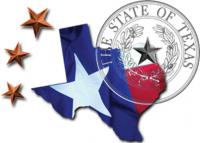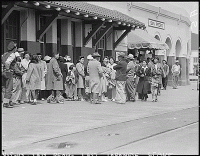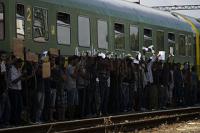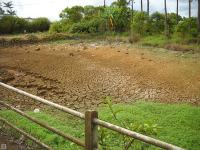-
New York City settles Muslim surveillance lawsuits

The NYPD has been agreed not to conduct surveillance based on religion, race, and ethnicity after charges that it had illegally monitoring Muslims in New York City. The city has agreed to settle two civil rights lawsuits for illegally monitoring its Muslim community following the September 11 attacks. As part of the settlement, in which the city does not admit to any wrongdoings, the city will appoint a civilian to monitor the NYPD’s counterterrorism unit.
-
-
Gov. Brown declares emergency in wake of massive L.A. natural gas leak
California governor Jerry Brown on Wednesday declared an emergency in a Los Angeles neighborhood where a natural gas well has been spewing record amounts of stinking, global-warming methane gas. Energy experts said the breach at the natural gas storage reservoir, and the subsequent, ongoing release, are the largest known occurrence of its kind.
-
-
Texas sues to block resettlement of Syrian refugees

The Texas Health and Human Services Commission on Wednesday filed suits in federal court against the U.S. State Department, the International Rescue Committee (IRC), and other organizations as part of the state effort to block the resettlement of Syrian refugees in Texas.
-
-
“Iconic” El Niño may bring more than rain to California
A few weeks ago in the hills north of Los Angeles, heavy rain set off widespread mudslides that blocked roads and covered highways, burying hundreds of vehicles and bringing much of Los Angeles’ infamous traffic to a standstill. For Californians, these mudslides are just one of many recent harbingers signaling the imminent arrival of a “monster” El Niño — an El Niño that started bubbling up from unusually warm temperatures in the tropical Pacific last summer. In Southern California, a strong El Niño usually signals rain, and given that California is now in the throes of a severe drought, it seems like that should be a good thing, even if it comes with risk of floods. But the reality of climate is more complex and counter-intuitive than it first appears, and Californians should be careful what they wish for.
-
-
Virginia mayor says WWII Japanese internment “inspires” his policies toward Syrian refugees

Roanoke, Virginia, mayor David Bowers (D) got into hot water on Wednesday when he issued a statement citing the U.S. internment of Japanese during the Second World War as an inspiration for his decision to delay assistance to Syrian refugees. Roosevelt, in the name of national security, ordered the forcible relocation of more than 100,000 Japanese immigrants and Japanese-Americans living in the United States to internment camps for more than three years. The internment is regarded as one of the most serious civil-liberties violations committed by the U.S. government.
-
-
Growing number of states say they would not accept Syrian refugees

A growing number of states have said they would not accept Syrian refugees because of security worries in the wake of the terrorist attacks in Paris. So far, the governors of seventeen states have announced they would refuse to allow Syrian refugees to settle in their states: Alabama, Arizona, Arkansas, Florida, Georgia, Illinois, Indiana, Iowa, Louisiana, Massachusetts, Michigan, Mississippi, New Hampshire, North Carolina, Ohio, Texas, and Wisconsin.
-
-
Update issued for southeast Florida regional sea level rise projections
The four-county Southeast Florida Regional Climate Change Compact (Compact) has prepared an update to the regional sea level rise projections used for important planning purposes. Overall, the update includes minor changes to the short-term curves, but a more significant increase in the mid-and long-term projections. The 2015 update estimates sea level rise of 6 to 10 inches by 2030, or 3 to 5 inches above average sea level in 2015. Predictions for the mid-term are between 11 and 22 inches of additional sea level rise by 2060, and longer-term between 28 and 57 inches by 2100.
-
-
New York proposes new sea-level rise projection regulations
New York State Department of Environmental Conservation (DEC) announced last week that to better prepare New York State coastal communities and business owners for extreme weather events like Superstorm Sandy three years ago, DEC is proposing new state sea-level rise projections which will help state agencies and project planners develop more resilient structures. “The sea-level rise projections DEC is proposing today reflect the best science available,” said DEC acting commissioner. “Sea level projections will help state agencies, developers, planners and engineers to reduce risks posed by rising seas and coastal storms over the next several decades.”
-
-
FEMA funding for post-Sandy recovery in New Jersey exceeds $6.8 billion

In the three years since Hurricane Sandy scored a direct hit on New Jersey, FEMA has provided $6.8 billion to date to help the state recover and rebuild. FEMA Public Assistance, which provides funds for repair and rebuilding of infrastructure and public facilities as well as necessary work such as debris removal and emergency response, has obligated $1.809 billion in Public Assistance funds towards repair and rebuilding projects in New Jersey.
-
-
Critics question Texas spending on border security
The Texas Department of Public Safety (DPS), and other state agencies, are prepared to spend between about $500 million and $800 million on border security. Critics maintain that whatever the final amount the Texas state legislature actually spends this year, it is money that would be better spent on items like education or health care rather than poorly defined “border security,” which is not the primary responsibility of either DPS or the state.
-
-
What would it take to end California’s drought?
The excitement about a potentially rain-bearing El Niño is building, and hopes for a swift end to California’s ongoing drought are multiplying. At the same time, many of us who have worked extensively on water issues in the state fear the momentum and progress made on much-needed water reforms will be lost. This will be unfortunate, because California’s current water situation offers an invitation to expand how we think about water and drought conditions. A more nuanced perspective about what drought means and our water needs can help continue the momentum on the shifts, such as conservation measures and groundwater management, needed to deal with what is certainly an uncertain future.
-
-
Past strategies for managing droughts are obsolete in a hotter, more densely populated world

California’s current extreme drought must be a lesson for managing water in a warmer, more densely populated world, experts say. The Golden State has a long history of successfully managing droughts, but strategies from the past century are now obsolete, they assert. The current drought, which began in 2012, is a harbinger of what is to come. Engineering our way around periodic water shortages will no longer work in a hotter, drier world with ceaseless human demands on water supplies. Our ever-increasing thirst for water coupled with poor management, aging infrastructure and worsening climate change is a recipe not just for wells run dry, but for ravaged forests, extinct wildlife, and more droughts. Targeted research and public policies that move beyond a crisis response mentality are critically needed, the experts conclude.
-
-
California offers driver's licenses to undocumented immigrants
This year California has begun to offer y undocumented immigrants driver’s licenses, and tens of thousands of immigrants have been standing long hours in line at the Department of Motor Vehicles offices around the state to avail themselves of the new document. DMV officials say that of the 883,000 licenses issued so far this year, 443,000 were issued to undocumented immigrants. The officials estimate that by the end of 2017, the DMV will issue more than 1.5 million driver’s licenses to undocumented immigrants in the state.
-
-
Historic drought complicates firefighting in California
The twenty-one wild fires which have erupted in different parts of the state have already cost lives, dozens of homes, and millions of dollars in damages. To fight fires, firefighters need water – and although state water and fire officials say that, so far, there is no danger of running out of water, they are conscious of the state’s water predicament and they are trying to be more careful in the use of water. The persistent drought has forced crews to get creative, using more dirt and retardant on wildfires. Firefighting response to several blazes has been slowed down by the drought, because firefighting helicopters found it impossible to siphon water from lakes and ponds where water levels were lower than in previous years. In the past, property owners whose properties were threatened by fire, would allow firefighting crews to tap water on their property, and would then be compensated by cash reimbursements from the state. Now, many property owners demand instead that the state replenish the water used by firefighters to protect the owners’ property.
-
-
Israel shares its approach, solutions to drought with California
Israel has developed expertise in coping with droughts, and a delegation from Israeli water companies recently visited California, meeting with state officials and corporations to propose solutions to the drought, now in its fourth year. It was the latest in a series of consultations and symposiums highlighting Israeli water expertise and its potential to help California.
-
More headlines
The long view
Smaller Nuclear Reactors Spark Renewed Interest in a Once-Shunned Energy Source
By David Montgomery
In the past two years, half the states have taken action to promote nuclear power, from creating nuclear task forces to integrating nuclear into long-term energy plans.
